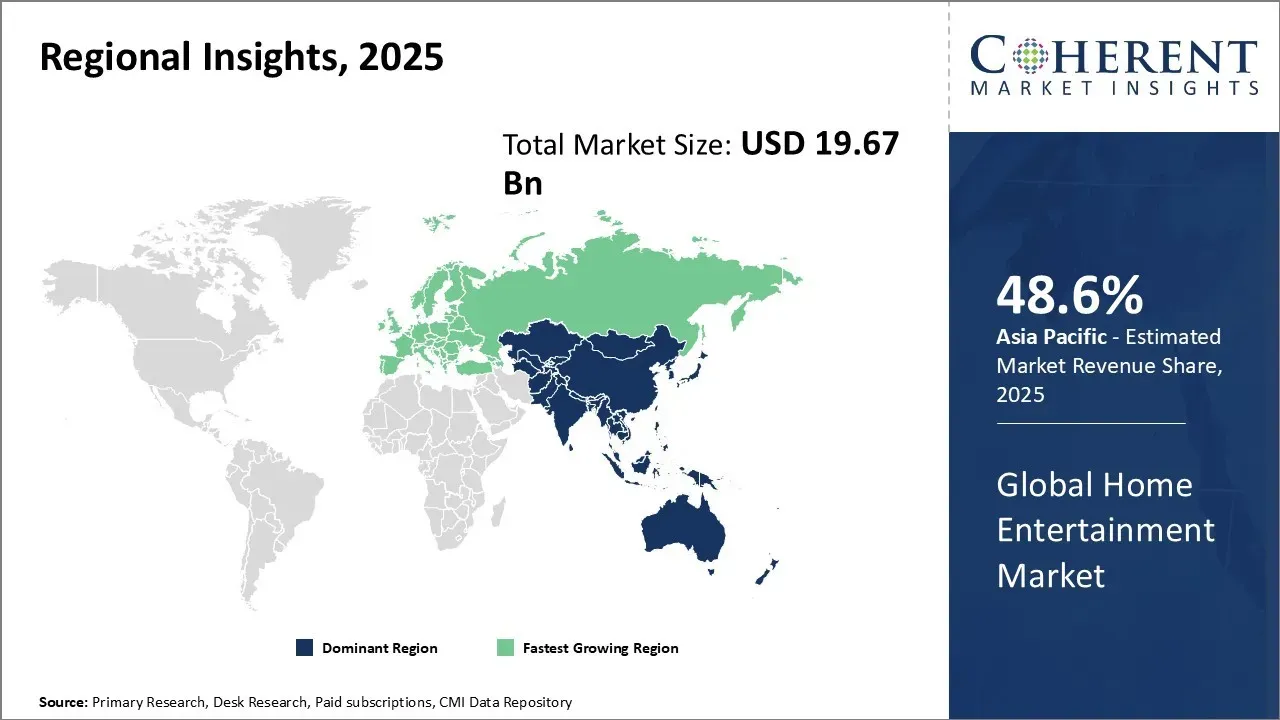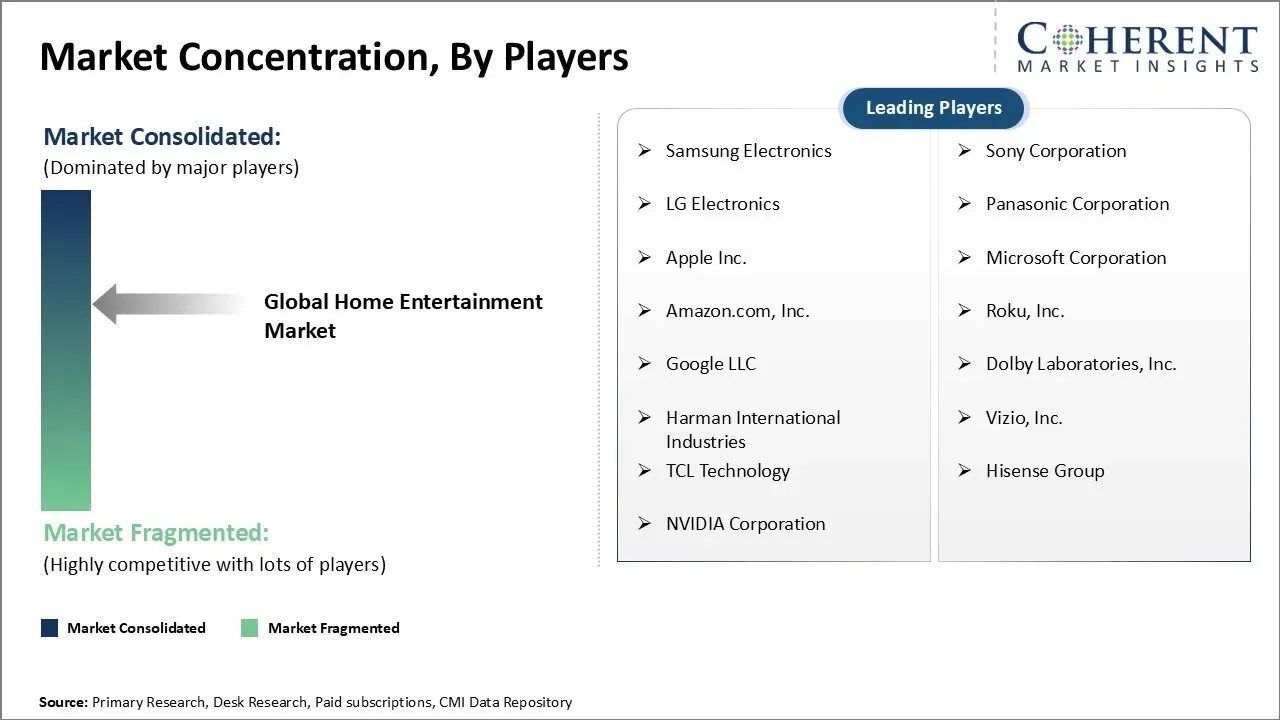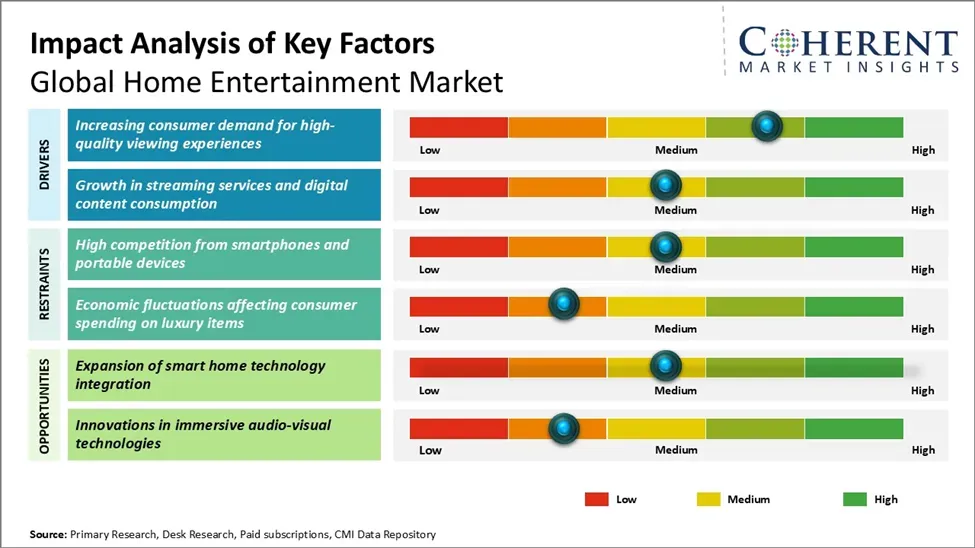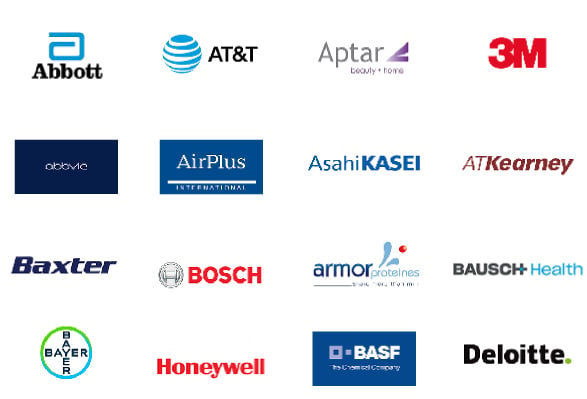The global home entertainment market is estimated to be valued at USD 19.67 Bn in 2025 and is expected to reach USD 30.82 Bn by 2032, exhibiting a compound annual growth rate (CAGR) of 6.6% from 2025 to 2032.
Key Takeaways of the Home Entertainment Market:
Market Overview:
The global home entertainment market has been witnessing the increasing adoption of advanced technologies in recent years. Factors such as rising demand for UHD/4K devices and proliferation of OTT media services and video streaming platforms have been driving the demand for enhanced home entertainment devices and experiences. Growing preference for in-house content consumption and improving high-speed internet connectivity are further expected to propel the market growth over the forecast period. However, threat from other entertainment avenues and growing popularity of mobile/out-of-home entertainment may challenge the market growth to a certain extent.
Product Type Insights – Improved Home Entertainment Experience Drives the Televisions Segment Growth
In terms of product type, the televisions segment is estimated to contribute 29.3% share of the market in 2025, owing to people's preference for television as a primary medium for home entertainment. Televisions offer the largest screen size available for viewing movies, sports, and other content at home in high picture quality. Advancements in television technology such as 4K/Ultra HD resolution and large screen sizes above 55 inches have enhanced the overall viewing experience. Content in these high resolutions can be experienced like never before on big screen televisions.
Application Insights - Residential Segment Dominates due to Preference for Experience Economy
In terms of application, the residential segment is estimated to contribute 67.4% share of the market in 2025, owing to changing consumer preferences for experience economy. People increasingly want meaningful experiences and ways to relax and entertain themselves at home. The COVID-19 pandemic reinforced the importance of creating entertainment hubs within homes. Home entertainment devices allow families to spend quality time together enjoying movies, sports, gaming, and others in the comfort of their living rooms. Devices catered for the residential segment provide easy to use and unified solutions for multi-room content access.
Distribution Channel Insights - Ease and Convenience Uplifting Online Retail Share
In terms of distribution channel, the online retail segment is estimated to account for 46.7% of the market share in 2025, propelled by consumers' growing preference for convenience. E-commerce platforms simplify the shopping experience by offering extensive product ranges, customer reviews, and attractive deals with just a few clicks. These platforms also address key consumer concerns by ensuring fast delivery services and hassle-free returns. Many retailers have introduced virtual product demonstrations and trial services, enhancing the online shopping experience. The broad reach of e-commerce surpasses the limitations of physical stores while perks such as loyalty programs, exclusive offers, and cashback further entice customers to shop online.

Need a Different Region or Segment? Customize now
Asia Pacific Home Entertainment Market Trends
The Asia Pacific region is expected to dominate the market with a 48.6% share by the end of 2025. This leadership is driven by factors such as robust consumer spending, the rapid adoption of smart home technologies, and the strong presence of leading industry players in the region. Additionally, the availability of convenient payment plans and access to premium content has further fueled the market expansion. Major platforms like Netflix, Amazon, Disney+, and Hulu have significantly contributed to the region's prominence in online video streaming.
Europe Home Entertainment Market Trends
Europe is projected to hold a 28.8% share of the market by the end of 2025. The region is experiencing rapid growth, establishing itself as a significant player in the industry. Factors such as swift modernization, growing disposable incomes, and expanding internet and smartphone usage are driving demand in countries like Germany and the U.K. Additionally, the presence of local OTT service providers and the affordability of devices are attracting a broad consumer base.
Home Entertainment Market Outlook for Key Countries
U.S. Home Entertainment Market Trends
The U.S. home entertainment market growth is driven by the increasing adoption of streaming services and smart home technologies. The launch of new streaming platforms has further fueled consumer interest in home entertainment solutions, leading to increased sales of advanced home entertainment products.
China Home Entertainment Market Trends
China is experiencing rapid growth in the home entertainment sector, primarily due to rising disposable incomes and urbanization. For instance, according to the Mintel 2023, the market is projected to grow by 10% in 2023, driven by the popularity of smart TVs and home theater systems.
Germany Home Entertainment Market Trends
Germany home entertainment market is characterized by a strong focus on high-quality audio and video systems. The introduction of new audio technologies, such as Dolby Atmos, has enhanced the home viewing experience. There's a significant shift towards digital streaming platforms like Netflix, Amazon Prime Video, and Disney+, influencing consumers to invest in smart TVs and advanced home entertainment systems.
India Home Entertainment Market Trends
The Indian home entertainment market is experiencing significant growth, propelled by increased internet penetration, affordable smart devices, and supportive government initiatives. A key contributor to this expansion is JioCinema, a streaming platform owned by Reliance Industries. JioCinema has secured agreements with major content providers, enhancing its offerings to cater to diverse consumer preferences. In April 2023, JioCinema partnered with Warner Bros. Discovery to stream HBO and Max original content, attracting a broader audience seeking premium international series and films.
Brazil Home Entertainment Market Trends
Brazil's home entertainment market is experiencing significant growth, driven by the increasing demand for affordable entertainment solutions. A key contributor to this expansion is Globoplay, a streaming service owned by Grupo Globo, Brazil's largest media conglomerate. Globoplay offers a vast array of content, including original productions, international series, and live broadcasting of Globo's channels. This diverse selection caters to a wide audience, enhancing the platform's appeal.

Get actionable strategies to beat competition: Request sample copy
Key Developments:
Top Strategies Followed by Global Home Entertainment Market Players
Emerging Startups - Global Home Entertainment Industry Ecosystem
Home Entertainment Market Report Coverage
| Report Coverage | Details | ||
|---|---|---|---|
| Base Year: | 2024 | Market Size in 2025: | US$ 19.67 Bn |
| Historical Data for: | 2020 To 2023 | Forecast Period: | 2025 To 2032 |
| Forecast Period 2025 to 2032 CAGR: | 6.6% | 2032 Value Projection: | US$ 30.82 Bn |
| Geographies covered: |
|
||
| Segments covered: |
|
||
| Companies covered: |
Samsung Electronics, Sony Corporation, LG Electronics, Panasonic Corporation, Apple Inc., Microsoft Corporation, Amazon.com, Inc., Roku, Inc., Google LLC, Dolby Laboratories, Inc., Harman International Industries, Vizio, Inc., TCL Technology, Hisense Group, and NVIDIA Corporation |
||
| Growth Drivers: |
|
||
| Restraints & Challenges: |
|
||
Uncover macros and micros vetted on 75+ parameters: Get instant access to report

Discover market dynamics shaping the industry: Request sample copy
Home Entertainment Market Growth Factors
Increasing consumer demand for high-quality viewing experiences
The entertainment industry has seen tremendous changes over the past decade driven primarily by technological advancements. With 4K and smart TVs becoming mainstream, consumers now expect a theater-like experience right in their living rooms. There is a growing need among audiences to stay connected even while relaxing at home after a long day at work. This has compelled manufacturers to integrate the latest display technologies in their products to provide viewers immersive experiences. Ultra HD resolution with higher pixel density allows watching content in unprecedented clarity and precision. Whether it is a big budget action movie or a live sporting event, consumers want to feel they are part of the action instead of just passively watching it from a distance.
Home Entertainment Market Challenge - High competition from smartphones and portable devices
The global market faces high competition from advanced smartphones and portable devices that offer seamless entertainment options. Many consumers now prefer using their smartphones and tablets to watch videos, play games, or listen to music instead of traditional TVs or gaming consoles at homes. Streaming apps and cloud-based services have made content easily accessible on mobile devices. This has reduced the dependency on fixed home entertainment appliances and systems. Younger generations in particular are spending more time on their smartphones for entertainment on the go. Equipment manufacturers need to offer more converged products that integrate connectivity and portability along with big screens for better experiences. Unless compelling advantages are provided, people may gradually shift entertainment budgets from dedicated home devices to multi-functional mobile gadgets over time.
Home Entertainment Market Opportunity - Expansion of smart home technology integration
The growing adoption of smart home technologies presents major opportunities for the market. Integration of entertainment devices with smart home platforms allows for unified control and automation. Viewers can access live and on-demand content, switch inputs, and adjust volumes using voice commands on smart speakers and displays placed around the house. Streaming content can also be mirrored wirelessly between TVs, tablets, and phones inside the home network. Partnerships between equipment brands and smart device makers will further improve the connectivity of entertainment hardware with smart home ecosystems. As standards evolve, full domination of the living space experience from a single interface can be realized.
Analyst Opinion (Expert Opinion)
Share
Share
About Author
Sakshi Suryawanshi is a Research Consultant with 6 years of extensive experience in market research and consulting. She is proficient in market estimation, competitive analysis, and patent analysis. Sakshi excels in identifying market trends and evaluating competitive landscapes to provide actionable insights that drive strategic decision-making. Her expertise helps businesses navigate complex market dynamics and achieve their objectives effectively.
Missing comfort of reading report in your local language? Find your preferred language :
Transform your Strategy with Exclusive Trending Reports :
Frequently Asked Questions
Joining thousands of companies around the world committed to making the Excellent Business Solutions.
View All Our Clients
US Reciprocal Tax Impact Analysis On Home Entertainment Market
Stay updated on tariff changes with expert insights and timely information